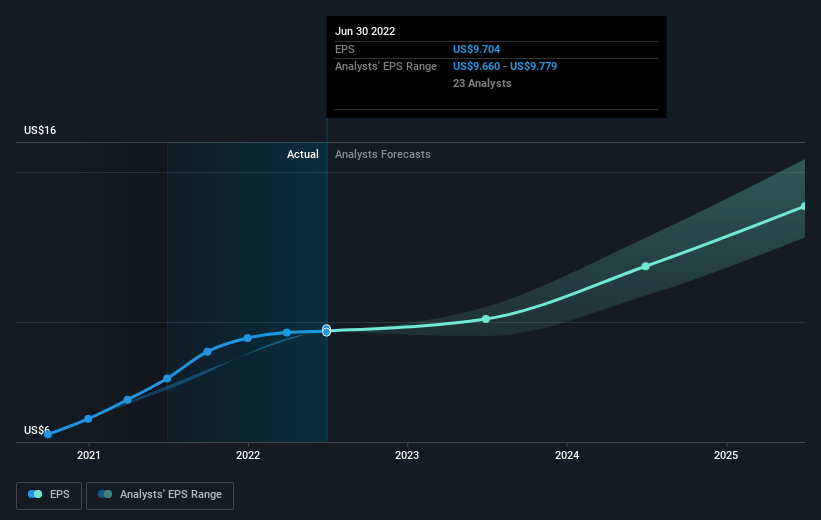Microsoft Corporation (NASDAQ:MSFT) shareholders might be concerned after seeing the share price drop 11% in the last quarter. But in stark contrast, the returns over the last half decade have impressed. In fact, the share price is 190% higher today. So while it’s never fun to see a share price fall, it’s important to look at a longer time horizon. Of course, that doesn’t necessarily mean it’s cheap now. Unfortunately not all shareholders will have held it for the long term, so spare a thought for those caught in the 25% decline over the last twelve months.
So let’s assess the underlying fundamentals over the last 5 years and see if they’ve moved in lock-step with shareholder returns.
See our latest analysis for Microsoft
There is no denying that markets are sometimes efficient, but prices do not always reflect underlying business performance. One imperfect but simple way to consider how the market perception of a company has shifted is to compare the change in the earnings per share (EPS) with the share price movement.
During five years of share price growth, Microsoft achieved compound earnings per share (EPS) growth of 24% per year. That makes the EPS growth particularly close to the yearly share price growth of 24%. That suggests that the market sentiment around the company hasn’t changed much over that time. Rather, the share price has approximately tracked EPS growth.
The image below shows how EPS has tracked over time (if you click on the image you can see greater detail).
We like that insiders have been buying shares in the last twelve months. Even so, future earnings will be far more important to whether current shareholders make money. It might be well worthwhile taking a look at our free report on Microsoft’s earnings, revenue and cash flow.
What About Dividends?
When looking at investment returns, it is important to consider the difference between total shareholder return (TSR) and share price return. The TSR incorporates the value of any spin-offs or discounted capital raisings, along with any dividends, based on the assumption that the dividends are reinvested. It’s fair to say that the TSR gives a more complete picture for stocks that pay a dividend. We note that for Microsoft the TSR over the last 5 years was 209%, which is better than the share price return mentioned above. The dividends paid by the company have thusly boosted the total shareholder return.
A Different Perspective
The total return of 24% received by Microsoft shareholders over the last year isn’t far from the market return of -25%. The silver lining is that longer term investors would have made a total return of 25% per year over half a decade. If the stock price has been impacted by changing sentiment, rather than deteriorating business conditions, it could spell opportunity. While it is well worth considering the different impacts that market conditions can have on the share price, there are other factors that are even more important. Case in point: We’ve spotted 1 warning sign for Microsoft you should be aware of.
If you like to buy stocks alongside management, then you might just love this free list of companies. (Hint: insiders have been buying them).
Please note, the market returns quoted in this article reflect the market weighted average returns of stocks that currently trade on US exchanges.
Have feedback on this article? Concerned about the content? Get in touch with us directly. Alternatively, email editorial-team (at) simplywallst.com.
This article by Simply Wall St is general in nature. We provide commentary based on historical data and analyst forecasts only using an unbiased methodology and our articles are not intended to be financial advice. It does not constitute a recommendation to buy or sell any stock, and does not take account of your objectives, or your financial situation. We aim to bring you long-term focused analysis driven by fundamental data. Note that our analysis may not factor in the latest price-sensitive company announcements or qualitative material. Simply Wall St has no position in any stocks mentioned.
Join A Paid User Research Session
You’ll receive a US$30 Amazon Gift card for 1 hour of your time while helping us build better investing tools for the individual investors like yourself. Sign up here





